Ketosis - Study guides, Class notes & Summaries
Looking for the best study guides, study notes and summaries about Ketosis? On this page you'll find 1117 study documents about Ketosis.
Page 2 out of 1.117 results
Sort by
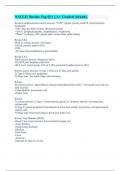
-
NAVLE: Bovine Top Q’s || A+ Graded Already.
- Exam (elaborations) • 15 pages • 2024
-
Available in package deal
-
- $11.99
- + learn more
Bovine Lymphosarcoma correct answers -*CNS*: [plegia, paresis, head tilt, facial paralysis, dysphagia] -*GI*: [free gas bloat, melena, thickened rectum] -*LN's*: [lymphadenopathy, exophthalmos, weight loss] -*Heart*: [collapse, CHF, jugular pulse, tachycardia, subQ edema] Bovine LSA: Dx & Tx correct answers -LN biopsy -ELISA: positive antbs to BLV -PCR -Tx: None (D-penicillamine is questionable) Bovine LSA: Pearls correct answers -Prognosis: Grave -Do NOT pass slaughter inspecti...
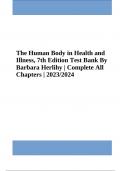
-
Test Bank For The Human Body in Health and Illness, 7th Edition By Barbara Herlihy | Complete 2023/2024 (VERIFIED)
- Exam (elaborations) • 340 pages • 2023
-
- $37.49
- 4x sold
- + learn more
Which of the following is most related to the conjunctiva? a. Is the mucous membrane that forms the inner lining of the eyelids b. Is the vascular layer of the eyeball; it supplies the retina with blood c. Is composed of circular and radial muscles d. Forms the cornea, the window of the eye ANS: A 80. On its way to the retina light does not pass through this structure. a. Pupil b. Vitreous humor c. Choroid d. Cornea ANS: C 81. Which of the following is not true of the lens? a. Chang...
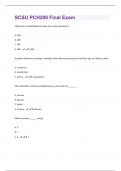
-
SCSU PCH200 Final Exam Questions And Answers
- Exam (elaborations) • 44 pages • 2024
- Available in package deal
-
- $7.99
- + learn more
100 grams of carbohydrate provides how many kilocalories? A. 200 B. 400 C. 500 D. 900 - B. 400 A protein deficiency resulting in swelling of the body tissue primarily in the feet, legs, and belly is called A. marasmus B. kwashiorkor C. ketosis - B. kwashiorkor After absorption, fructose and galactose are converted into _______. A. Lactose B. Glucose C. Xylitol D. Sucrose - B. Glucose Alcohol contains ______ kcal/g. A. 4 B. 7 C. 9 - B. 7All types of plant food, but not all animal...
![Diabetes [DKA/HHS Final Exam Questions] Questions with 100% Correct Answers | Latest Update 2024 | Verified](/docpics/4449063/65c4b7933242d_4449063_121_171.jpeg)
-
Diabetes [DKA/HHS Final Exam Questions] Questions with 100% Correct Answers | Latest Update 2024 | Verified
- Exam (elaborations) • 18 pages • 2024
-
Available in package deal
-
- $9.49
- + learn more
Diabetes [DKA/HHS Final Exam Questions] Questions with 100% Correct Answers | Latest Update 2024 | Verified 1. A patient with diabetes in the critical care unit is at risk for developing diabetic ketoacidosis (DKA) secondary to A. excess insulin administration. B. inadequate food intake. C. physiologic and psychologic stress. D. increased release of antidiuretic hormone (ADH). - ANS C physiologic and psychologic stress. Major neurologic and endocrine changes occur when an individual is con...
![Diabetes [DKA/HHS Final Exam Questions] Questions with 100% Correct Answers | Latest Update 2024 | Verified](/docpics/4449126/65c4b92e3d113_4449126_121_171.jpeg)
-
Diabetes [DKA/HHS Final Exam Questions] Questions with 100% Correct Answers | Latest Update 2024 | Verified
- Exam (elaborations) • 18 pages • 2024
-
Available in package deal
-
- $9.49
- + learn more
Diabetes [DKA/HHS Final Exam Questions] Questions with 100% Correct Answers | Latest Update 2024 | Verified 1. A patient with diabetes in the critical care unit is at risk for developing diabetic ketoacidosis (DKA) secondary to A. excess insulin administration. B. inadequate food intake. C. physiologic and psychologic stress. D. increased release of antidiuretic hormone (ADH). - ANS C physiologic and psychologic stress. Major neurologic and endocrine changes occur when an individual is con...

-
NREMT Paramedic questions with correct answers
- Exam (elaborations) • 112 pages • 2024
- Available in package deal
-
- $13.99
- + learn more
what is HHNK? CORRECT ANSWER Hyperglycemic Hyperosmolar Non-ketosis coma, complication of DM Type 2. S&S of DKA but no fruity breath or kussmauls breathing. what are the two types of immunity? CORRECT ANSWER natural and acquired what type of reaction is an allergic reaction? what type of protein is the antibody? *high pt* CORRECT ANSWER antigen-antibody reaction. IgE immunoglobulins When histamine is released, what is the affect on the body? CORRECT ANSWER vasodilator, increases capilla...
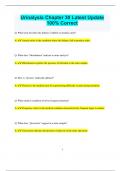
-
Urinalysis Chapter 30 Latest Update 100% Correct
- Exam (elaborations) • 12 pages • 2024
- Available in package deal
-
- $9.99
- + learn more
Urinalysis Chapter 30 Latest Update 100% Correct Q: What term describes the kidneys' inability to produce urine? A: Anuria refers to the condition where the kidneys fail to produce urine. Q: What does "bilirubinuria" indicate in urine analysis? A: Bilirubinuria signifies the presence of bilirubin in the urine sample. Q: How is "dysuria" medically defined? A: Dysuria is the medical term for experiencing difficulty or pain during urination. Q: What medical condition invol...
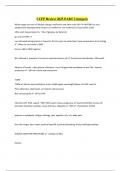
-
CCFP Review 2025 PART 2 (largest)
- Exam (elaborations) • 144 pages • 2024
-
Available in package deal
-
- $10.49
- + learn more
CCFP Review 2025 PART 2 (largest) When target not met w/ lifestyle change, metformin and other orals OR if in HHS/DKA or very symptomatic hyperglycemia (remain on metformin, not combined w/ most other orals) often start long acting at hs, ~10u of glargine (or detemir) go until am FBG <7 can add rapid acting (aspart or lispro) to 10 mins prior to meals (decr hypo compared to short acting) ️When to use insulin in DM2 How to add to DM2 regimen BS >14mmol/L, presence of u...
![Diabetes [DKA/HHS Final Exam Questions] Questions with 100% Correct Answers | Latest Update 2024 | Verified](/docpics/4088167/658ae6c30d738_4088167_121_171.jpeg)
-
Diabetes [DKA/HHS Final Exam Questions] Questions with 100% Correct Answers | Latest Update 2024 | Verified
- Exam (elaborations) • 18 pages • 2023
- Available in package deal
-
- $11.99
- + learn more
1. A patient with diabetes in the critical care unit is at risk for developing diabetic ketoacidosis (DKA) secondary to A. excess insulin administration. B. inadequate food intake. C. physiologic and psychologic stress. D. increased release of antidiuretic hormone (ADH). - ANS C physiologic and psychologic stress. Major neurologic and endocrine changes occur when an individual is confronted with physiologic stress caused by any critical illness, sepsis, trauma, major surgery, or underlyin...
![Diabetes [DKA/HHS Final Exam Questions] Questions with 100% Correct Answers | Latest Update 2024 | Verified](/docpics/4088186/658ae825e3195_4088186_121_171.jpeg)
-
Diabetes [DKA/HHS Final Exam Questions] Questions with 100% Correct Answers | Latest Update 2024 | Verified
- Exam (elaborations) • 18 pages • 2023
- Available in package deal
-
- $11.99
- + learn more
1. A patient with diabetes in the critical care unit is at risk for developing diabetic ketoacidosis (DKA) secondary to A. excess insulin administration. B. inadequate food intake. C. physiologic and psychologic stress. D. increased release of antidiuretic hormone (ADH). - ANS C physiologic and psychologic stress. Major neurologic and endocrine changes occur when an individual is confronted with physiologic stress caused by any critical illness, sepsis, trauma, major surgery, or underlyin...

$6.50 for your textbook summary multiplied by 100 fellow students... Do the math: that's a lot of money! Don't be a thief of your own wallet and start uploading yours now. Discover all about earning on Stuvia


